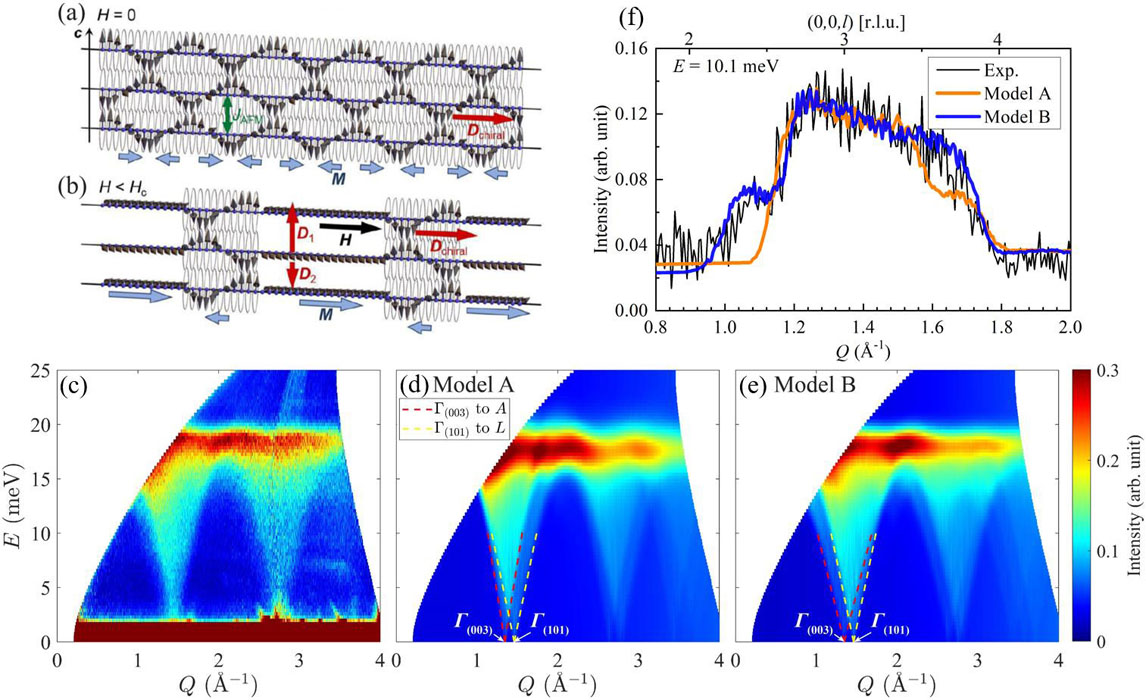Spin Excitation in a Chiral-Polar-Corundum Compound Ni2InSbO6
Masuda Group
In some types of non-centrosymmetric magnets, spin moments are incommensurately arranged to balance Dzyaloshinskii–Moriya (DM) and Heisenberg interactions. This leads to helimagnetic spin textures and spin soliton lattice which exhibit distinctive magnetoelectric response and promising potential for applications in spintronics. A chiral-polar-corundum compound Ni2InSbO6 is an example for a proper-screw type spin structure realized by chirality-induced DM interaction [1], as shown in Fig. 1(a). In conventional helimagnets, a spin soliton lattice is induced in the magnetic field applied in the spin rotation plane. In contrast in Ni2InSbO6, the soliton lattice was proposed by a unique scenario. Suppose that additional DM interactions with the staggered vector component D1 and D2 along the polar c axis are assumed, as shown in Fig. 1(b). At zero magnetic field, localized magnetization components M are induced by D1 and D2 interacting between neighboring Ni2+ ions along the c axis, indicated by the light blue arrows in Fig. 1(a). In the magnetic field applied perpendicular to the spin rotation plane, they shrink or expand to minimize Zeeman energy, and hence the spin soliton lattice is realized. In previous Raman study [2], however, the spectrum was analyzed by the spin model assuming that the first and second neighbor Heisenberg interactions J1 and J2 were equal, corresponding that D1 and D2 were equal. The assumption was contradictory to the scenario based on the staggered DM vectors. Thus, in this work, we collected magnetic spectrum in wide momentum-energy space on Ni2InSbO6 by inelastic neutron scattering (INS) technique to identify the precise spin Hamiltonian and validate the mechanism of the spin soliton lattice [3].

Fig. 1 Schematic of (a) proper-screw type helical spin structure and (b) spin soliton lattice in Ni2InSbO6. The figures were adopted from Ref. [1]. (c) INS spectrum measured with Ei = 30.5 meV at T = 10 K. (d),(e) Powder averaged LSWT calculation of INS spectra using the best fit parameters for model A in (d) and model B in (e). Modes of spin wave excitation from Γ(003) to A(00 3/2) and from Γ(101) to L(1/2 0 1/2) points are described by red and yellow dashed lines, respectively. (f) 1D-cut of powder spectrum at E = 10.1 meV for experiment (black), model A (orange) and model B (blue).
The INS powder spectrum is shown in Fig. 1(c). Well-defined spin wave excitation is observed with the band energy of 20 meV at 10 K. Two spin models of antiferromagnetic Heisenberg Hamiltonian considering the first to fourth nearest neighbor interactions J1 to J4 are used to analyze the spectrum by the linear spin-wave theory (LSWT). The calculated spectra of model A with constraints J1 = J2 and J3 = J4 according to the previous Raman study [2] and model B without the constraints according to the crystallographic consideration are shown in Figs. 1(d) and 1(e), respectively. χ2 and correlation coefficient R for model A were 8.8 and 0.928, and those for model B are 6.1 and 0.953, meaning that model B is more probable. Indeed, one-dimensional cuts of the experiment and calculations at the energy of 10.1 meV in Fig. 1(f) suggest that the model B reproduces the experiment better. The difference is, in fact, caused by the fast and low spin wave velocities along the c axis for model A and B, respectively. The spin model of Ni2InSbO6, thus, turns out to be a coupled two-dimensional lattice stacked along the c axis with intraplane interaction J1 = 6.05 meV and interplane interaction J1 = 0.95 meV. Since DM interaction is proportional to the corresponding exchange interaction, D1 and D2 are different as well, which validates the mechanism of spin soliton lattice [1].
References
- [1] Y. Araki, T. Sato, Y. Fujima, N. Abe, M. Tokunaga, S. Kimura, D. Morikawa, V. Ukleev, Y. Yamasaki, C. Tabata, H. Nakao, Y. Murakami, H. Sagayama, K. Ohishi, Y. Tokunaga, and T. Arima, Phys. Rev. B 102, 054409 (2020).
- [2] M. A. Prosnikov, A. N. Smirnov, V. Y. Davydov, Y. Araki, T. Arima, and R. V. Pisarev, Phys. Rev. B 100,144417 (2019).
- [3] Z. Liu, Y. Araki, T. Arima, S. Itoh, S. Asai, and T. Masuda, Phys. Rev. B 107, 064428 (2023).
